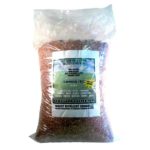Bugs don’t get much scarier than ticks. The truth is almost no bug bite can change the course of your life the way a tick’s can. In other words, if you venture outdoors often, have a family, or pets, you need to be extra careful to avoid tick bites and ensure these blood-sucking arachnids are nowhere near home. Here’s how to prevent, repel, and get rid of Ticks naturally in just 3 easy steps.
Step 1: Prevent Dangerous Tick Bites
Did you know many tick bites originate, not in wooded areas, but in our own lawns, or during common activities like dog walks?
It’s for this reason that you, your family and pets need to wear an effective yet safe tick repellent when venturing outdoors, whether camping and hiking, or simply working or playing in your own yard with your family.
Wearing a tick repellent is crucial for two main reasons. First, it helps prevent painful and in some cases life-threatening tick bites. Second, it helps prevent you from accidentally introducing ticks into your lawn or home, exposing your loved ones to dangerous ticks.
Before outside fun like walks, hikes, dog walks, BBQs, camping, and outdoor entertaining, simply apply DG’s non-toxic Bug Off Cedar Oil Personal and Pet Spray to you, your family, and pets to kill and repel, not only ticks, but also mosquitoes, fleas, ants, mites, bed bugs, and other biting or damaging pests. For best results, reapply to people every 5-7 hours or after getting wet, and reapply to pets every other day or more often as needed. No more bug bites. No poisonous chemicals. It’s that easy!
Pro Tip: In addition to preventing tick bites, DG’s Personal and Pet Cedar Oil Spray can also be used indoors to kill and repel bugs around the house without resorting to dangerous pesticides.
Step 2: Tick-Proof Your Lawn
By taking a few simple preventative steps and keeping up with lawn care, you can dramatically reduce the chances of experiencing ticks in your yard. Without moisture to drink, sources of food like wild animals, and hiding spots to breed, ticks will have little interest in staying in your lawn. Here are some essential tips for tick-proofing your lawn:
- Lawns with excess moisture are very attractive to ticks, so make sure to remove or repair all sources of unnecessary moisture, including leaky plumbing, sprinklers & hoses, clogged drainage areas, and items that collect rainwater, such as unused furniture and equipment.
- Practice regular lawn maintenance, including keeping your grass and shrubbery short and trimmed. Mow, weed eat, and trim as needed. Ticks love hiding out in lawn clippings, so make sure to bag those, too.
- Remove organic clutter like wood piles, brush, leaves, and any mulch not made from cedarwood, these are a favorite hideout for ticks.
Wildlife like raccoons and deer commonly drop ticks into our yards. Here are some natural ways to help keep tick-carrying pests off your property
- Especially if you live in a wooded area, we strongly suggest installing fencing, at least around the most used areas of your lawn.
- If you already have fencing, make sure to check it periodically for holes and other damage animals could use to gain entrance.
Garbage is a big attractant for wild animals. Firmly secure any trash cans, recycling bins, or compost piles you have outside to help avoid unwelcome guests. - Avoid installing plants known to attract wild animals, like roses, beans, tulips, peas, corn, apples, etc. If you’ve already planted some of these, consider installing some barrier to keep wildlife out, like chicken wire.
Step 3:Kill & Repel
Apart from ensuring you, your family, and pets are protected from dangerous bites, removing ticks from your yard and keeping them away is your top priority.
Don’t worry, killing & repelling ticks in all life stages—egg, larva, nymph, and adult—is quick, safe, and easy with DG’s plant-based Lawn and Kennel Concentrate.
Start by treating your entire yard with non-toxic, pet-safe
Lawn and Kennel Concentrate twice about two weeks apart. Make sure to spray your front, back, and side yards, including shrubbery, small trees, and bases of larger trees. After those first two treatments, you can proceed to monthly applications. Can use more often if needed for heavier bug populations.
Because ticks can survive winter conditions, they tend to be a problem all year long. For this reason, we strongly urge you to continue monthly applications throughout the entire year.
Doing this will also save you a bunch of time, money, and headache when things start to warm back up and ticks, along with mosquitoes, fleas, ants, chiggers and more, become an even larger problem again.
Not So Fun Fact: Ticks can survive all winter long, even in freezing temperatures
For added repellency, broadcast Cedar Granules throughout your lawn or at least in those areas where you and your family spend the most time. Reapply Cedar Granules every 6 weeks.
Need help or have questions?
Phone: 714-402-9419
Email: Wayne@dgcedaroil.com





